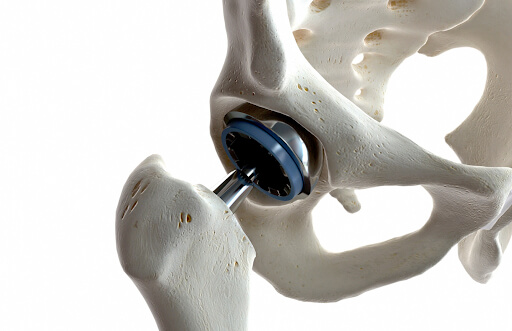Smart Implants: Revolutionizing Orthopedic Surgery

Introduction
Orthopedic surgery has come a long way in improving the lives of millions of people around the world suffering from conditions such as osteoarthritis. Traditional orthopedic implants, such as those used in total hip arthroplasty (THA) and total knee arthroplasty (TKA), have been the go-to solution for pain relief and improved function. However, a new era of medical devices is on the horizon – smart implants. These innovative devices, such as smart dental implants and others, incorporate technology to treat various conditions and detect and diagnose them, ushering in a new era of digital transformation in healthcare.
The Rise of Smart Implants
Innovative implants are reshaping orthopedic surgery by integrating with the human body and providing real-time data to patients and healthcare providers. These devices utilize sensors, microprocessors, and other electronic components to measure pressure, force, strain, stress, displacement, proximity, and temperature inside the body. This wealth of data from smart implant solutions enables healthcare providers to monitor the health and function of the implant, leading to more informed decisions about patient care and treatment.
The development of smart implants is a relatively recent phenomenon, with some of the first devices being introduced in the early 2000s. Since then, the technology has evolved rapidly, resulting in more sophisticated and capable devices. Companies like VeraSense and OrthoSensor have been at the forefront of this innovation, creating smart orthopedic devices and implants that are currently being used in clinical practice.

Benefits for Patients and Providers
Innovative implants offer a range of benefits for both patients and healthcare providers. These devices can improve patient outcomes by providing real-time monitoring, personalized care, increased patient engagement, and high-quality data.
Real-Time Monitoring
One key advantage of smart implants is their ability to continuously monitor a patient’s condition after surgery. By tracking various parameters, these devices can optimize the healing process and potentially reduce the need for frequent hospital visits. Real-time monitoring also enables early detection of implant loosening or failure, allowing for timely interventions and improved patient outcomes.
Personalized Care
Smart implants provide valuable feedback on a patient’s condition, allowing healthcare providers to tailor their treatment plans accordingly. By monitoring parameters such as range of motion and muscle strength, providers can make informed decisions about adjustments to the treatment plan and guide patients through rehabilitation. This personalized approach to care enhances the recovery process and ensures that patients achieve the best possible outcomes.
Also read: All You Need to Know about Healthcare Technology.
Increased Patient Engagement
Smart implants empower patients to take an active role in their own recovery. With access to their implant data, patients can monitor their progress, set goals, and track their achievements. This increased engagement improves patient satisfaction and improves treatment adherence and overall outcomes.
High-Quality Data
The adoption of smart implants in clinical practice generates a wealth of data that can be used for research and clinical studies. Unlike traditional data collection methods, which often rely on patient compliance, smart implants provide real-time data, reducing patient burden and ensuring higher quality and quantity of data. This data-driven approach can advance orthopedic research and contribute to developing more effective treatment strategies.

Overcoming Challenges
While the potential of smart implants is promising, several challenges must be addressed for widespread adoption.
Safety and Reliability
Smart implants are designed to be used inside the human body, making safety and reliability paramount. Factors such as the choice of materials, device design, and manufacturing process all play a crucial role in ensuring the safety and reliability of these devices. Extensive testing and regulatory compliance are essential to address these challenges and instill confidence in patients and healthcare providers.
Regulatory Hurdles
Smart implants are subject to rigorous regulatory requirements, including approval from regulatory bodies such as the US Food and Drug Administration (FDA). Navigating the regulatory landscape can be complex and time-consuming, requiring significant clinical trial and documentation investment. Streamlining the regulatory pathway for smart implants would facilitate their adoption and accelerate innovation in this field.
Cost Considerations
The development and manufacturing of smart implants can be costly, posing a barrier to access for some patients and healthcare providers. Finding ways to reduce costs without compromising safety and effectiveness is essential to make smart implants more affordable and accessible to a broader population. Collaboration between manufacturers, healthcare providers, and insurers can help address these cost considerations and ensure equitable access to this transformative technology.
Privacy and Cybersecurity
As smart implants generate and transmit sensitive patient data, ensuring privacy and cybersecurity becomes a critical concern. Robust data protection measures, encryption protocols, and secure data storage are vital to safeguard patient information. Manufacturers and healthcare providers must work together to implement stringent cybersecurity measures and maintain patients’ trust in this digital age.
The Future of Smart Implants
Despite the challenges, smart implants hold tremendous potential for revolutionizing orthopedic surgery. As technology advances, these devices will become increasingly sophisticated and effective in improving patient outcomes. Ongoing research and collaboration between industry stakeholders will pave the way for developing next-generation innovative implants that redefine the standard of care in orthopedic surgery.
With continuous innovation and refinement, smart implants can transform orthopedic surgery into a more personalized, data-driven, and patient-centric field. By harnessing the benefits of innovative technology, healthcare providers can deliver better outcomes, improve patient satisfaction, and drive advancements in orthopedic research. As we embrace the future of smart implants, a new era of orthopedic surgery dawns, promising a brighter future for patients and providers alike.
![Blog-[x]cube LABS](https://d6fiz9tmzg8gn.cloudfront.net/wp-content/uploads/2016/06/blog_banner.jpg)






